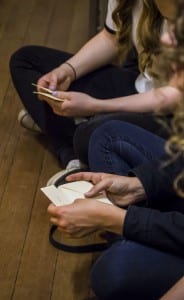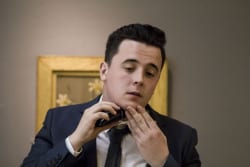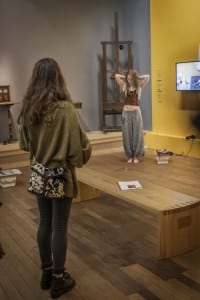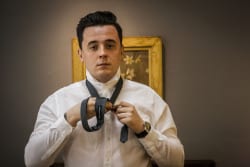Influenced by artists such as Marina Abramovich, Brett Bailey and Guillermo Gomez-Pena, we sought to create a deeply personal piece, that challenged us physically, emotionally and mentally.
The result was Skin Deep(er), a performative piece of art with 5 performers that explored identity under the constraints of social conventions, by forming their own appearance and having it altered by the other bodies, exploring the way in which the site manipulates and influences people’s perceptions of identity. We invited the general public to view our piece at 1:30 PM on the 9th May 2015 at the Usher Art Gallery in Lincoln.
Whilst a very simple piece to watch, it was the result of hours upon hours of work. As a group we spent the last few months constantly researching and thinking, looking not only for academic and artistic inspiration, but looking directly at ourselves, with the aim to learn who we really are, and asking ourselves,what personas do we adopt in everyday life?
The Process
As this module was our first encounter with Site Specific Performance, it was important that before we started working on our piece, we had to engage with what Site Specific Performance actually is.
I think Pearson summarised it best
‘Performance can function as both an innovative
mode of enquiry and a research
output:
as a critical address
shifting from the optic to the haptic
reading ‘onto’ (as fiction) as well as reading ‘from’ (as documentary)
What happens here, has happened here, might happen here?
as a mode of encounter
encouraging active engagement and apprehension: performing visitation
problematising notions of landscape as a purely visual construct
occasioning a critical reappraisal of the inherent qualities of places rarely
visited
as a means of exposition and representation
at site or elsewhere
pointing to this and that
animating; precipitating visitation and participation’ (Pearson, 2011, 1)
After considering Pearson’s views on performance, we began engaging with the site (both the museum and art gallery), and began to think critically about how these two institutions are composed.
Here are very two short blog posts about my first few sessions at the site.
1) On the 28th January, I had my first visit to the Usher Gallery & The Collection. The Usher Gallery is primarily an Art gallery, showcasing many different styles of Art, while The Collection focuses more on archaeological pieces and history. However, The Collection is currently hosting an Art Exhibition called ‘Viewpoints’, which examines the different ways in which Art can be viewed and analysed, and how different environments and emotions can affect the way Art is viewed.
After looking around the ‘Viewpoints’ exhibition, I was asked to create a one minute performance, as a response to a particular painting, and perform it on the 4th February. I made a conscious decision not to find out the name of the piece, or anything about the artist and the context of the painting, at least not until after the performance. The reason for this is I wanted to create a more personal response, based entirely on my perception of the piece. I found that the piece gave an insight into the notion that ‘Life Imitates Art’, and this has served as the basis for my performance (As there was no photography allowed in the exhibition, I can’t include a picture, however one will be included in next week’s blog, along with an analysis of the performance).
See you next week!
2)Sir Alfred Munning’s ‘Does the Subject Matter?’ is the piece that I was given to examine last week. The piece is a reflection of Munning’s opinion on the state of modern art, with grotesque figures examining strange sculptures and paintings by Picasso (an artist that Munning hated). In this piece Munning satirises fans of modern art, possibly commenting on those that pretend to appreciate modern art only in an attempt to appear intellectual, in order to raise their cultural capital, whilst not actually understanding or even enjoying the art. However, as I stated in last week’s blog, when preparing my response to this piece, I chose not to look at the artist or his intention, in order to give an honest response to what I thought the piece was saying. I felt that the piece was a comment on the notion that ‘Life Imitates Art’, and that people were just as beautiful and artistic as the pieces that were displayed in galleries. My script follows thus
‘The Audience will line up outside The Collection, and will be kept waiting for five minutes. The photographer will come out, and take pictures of the Audience with a Polaroid camera. The Audience will then be brought in, and made to line up outside the education room. The photographer will again take pictures of the audience, and after the Photographer enters the Education room, the Audience will be kept waiting for another five minutes. When they finally enter the Education room, the walls will be covered in the photographs. The Audience are encouraged to look at the photographs. The Audience become the Art.’ (Mortimer, 2015)
Whilst I fully stand by my initial response to the painting, I find it humorous that Munning himself probably would have dismissed my performance as nonsensical modern art, and that his piece inspired the type of art that he himself hated.
This initial task allowed us to start engaging with the site, and to not only understand what was there, but why it was there, and even more importantly to us-what kinds of art were excluded. The majority of the artwork displayed at the Usher was created by middle class white men, for middle class white men. There were numerous images of women, nude and clothed, but so very few were actually created by women. After these realisations, our ideas began to germinate.
As a group of people from very different backgrounds, we thought that our stories could be as valid a piece of art as any that was hanging from the walls of the Usher. We started spending a lot of time together, just talking about ourselves, our upbringings, and our values, learning more about each other and ourselves after every meeting. Our initial idea was to stand in a room in the Usher gallery, in our underwear, blindfolded. We were going to leave ‘guestbooks’ in front of us, inviting the audience fill in a questionnaire about their preconceptions of us, for example asking what they thought about our sexuality, criminal history etc. We decided to change our idea very quickly for two main reasons, the first being that there was no guarantee that the audience would fill in the questionnaires, the second reason being that this performance would not explore our personality enough. It was then we really started to dig deep into ourselves.
I was born into a very working class family at the border between Essex and East London, and I moved out into a more affluent area of Essex when I was ten years old. I have encountered all manors of people, and have never been able to identify completely with any social group, or social class that I have encountered. My parents had very different aspirations than many people I knew from the part of London I was born in, not content to stay in an area dominated by high rise flat blocks, Class A drugs, and violent street crime. I was always taught as a child that the world was much more than just London.I felt no more at home when I moved. I had never met people like this before, their parents drove Range Rovers, owned horses and went on skiing holidays. Hardly the top 1% of the population, but still a whole new world for me.
This may seem like a lot of unnecessary personal information, but it was through exploring my upbringing that I realised that throughout my life I was constantly performing under different personas. After looking at these personas, I realised that it was my sense of masculinity, or at least a form of masculinity that was appropriate for that time, that formed a large part of them. This was what led me to create my persona for the piece.
Brett Bailey’s controversial piece ‘Exhibit B’ was incredibly influential to us. A piece centred on the theme of race, presented bodies of African descent, in human zoo style enclosures. “Spectators enter the site-specific location one-by-one and travel through the rooms of the exhibition. The performers, trapped in tableaux vivants, stare back”(Bailey, 2015). This gave us the idea to create ‘enclosures’ for our personas, and to attempt to present them as ‘living’ in a human zoo scenario.
La Pocha Nostra were also a huge influence on our piece. They were founded in 1993 by Guillermo Gomez-Pena, La Pocha Nostra work with artists of all races, sexualities and ages to create ‘rebellious artists’, “We become the spectacle of our identities using our highly decorated bodies. In this sense we are always, physically, culturally and technologically hybrid beings.” (The Pocha Nostra Manifesto, 2012). We worked through their book ‘Exercises for Rebel Artists: Radical performance pedagogy’ , in order to strengthen our own personas. One of the exercises we tried was adopting each others personas, which involved swapping clothes and ‘performing’ in the gallery space. This exercise was useful as it showed us the varying levels of depth we had achieved with our personas, and gave us clear points to work on.
One of the most useful exercises we used from ‘Exercises for Rebel Artists’, involved asking questions about our personal beliefs. We would stand in different points along a scale in the room, from 1 to 10 , depending on our response to the questions.
How patriotic are you?
How sexually liberated do you feel?
Are you open to immigration?
How sexually promiscuous are you?

This exercise forced us to think about subjects we didn’t necessarily consider very often, and not only strengthened our personas, but inspired us to really try and make a statement with our piece.
The aspect of the performance that took longest to rehearse was our ‘living’ segment of the piece. It was important to us that it did not look like we were acting’, rather we were embodying completely the persona that we adopted. Finding a balance between something that was visually stimulating, whilst still feeling and appearing ‘real’ was a challenge for us.
Performance
Marketing Text: Fetishised, Masculine, Meditative, Rebellious, Queer. Five vessels used to explore their own identities and those imposed upon them. We invite you to come and observe this silent journey of self-discovery.
This Performance contains partial nudity.
Framing Statement: A performative piece of art with five performers that explores identity under the constraints of social conventions, by forming their own appearance and having it altered by the other bodies, exploring the way in which the site manipulates and influences people’s perceptions of identity.
Skin Deep(er) featured five bodies standing in a room. Each body was only clothed in plain black underwear, with a ‘costume’ laid out in front of us, and a box full of objects to the left of us. Every three minutes, we would put on one item of clothing, until we were fully dressed. Then, one at a time, we walked to the body to the left of us, moved them into a tableau that was a visual representation of that body’s persona. Once everyone had held their tableau, we began to build our enclosures with the objects we had in our boxes, then we ‘performed’ our persona to the audience for ten minutes. We then put the objects back in the box, then proceeded to slowly get undressed, reverting back to the initial image. This process was then repeated.
The Personas
The Fetishised Body
The Masculine Body
The Meditative Body
The Rebellious Body
The Queer Body
My persona
I decided to embody The Masculine Body, or atleast my take on the masculine body. Rather than highlight more traditional masculine traits, i.e. physical strength, athleticism etc, I chose to model my interpretation on a 21st century YUPPIE type, more Gordon Gekko than Conan the Barbarian. I put on a suit, an armani watch, and I made sure my shoes and hair were pristine. I wanted my enclosure to reflect this materialistic view on masculinity, so the objects I had in my box were
A Broadsheet Newspaper
A Can of Hairspray
A Tub of Hair Gel
A Bottle of Calvin Klein Aftershave
A Bottle of Versace Aftershave
A Bottle of Hugo Boss Aftershave
A Hand-Mirror
For the ‘living’ segment of the piece, I spent my time shaving, adjusting my tie, fixing my hair, and looking in the mirror. My attention was focused mostly on the female members of the audience, as I felt this hyper-masculine persona would not be interested in the males in the room.
We each had five cards, that we wrote a series statements about our persona on. Each card had a statement starting with ‘My body is’, a quote we thought represented our persona, a confession, and then a statement that subverted our persona. At various points throughout the ‘living’ segment, we handed these cards out to members of the audience. My card read
My body is everything
Show no love-Earl Simmons
No one has seen me cry since I was nine years old
I feel uncomfortable getting changed in front of other men
Performance Evaluation
The performance ran relatively smoothly, with no major problems. Unfortunately our audience sat in front of the entrance to the room, which potentially discouraged others from watching. Every audience member that was beckoned over to receive a card came willingly, with the exception of Conan, who flat out refused to move. This was an interesting development for us, as we did not expect one of the examiners not to cooperate with our performance, so we were forced to perform our way through this obstacle.
If performed again, I would encourage the audience to freely walk around the performance, interacting with the personas through the use of signs. I would also like to create a more elaborate enclosure, as I feel it would help develop an even deeper understanding of the persona. From a purely performative standpoint, I would have liked to have rehearsed getting dressed and undressed even more, because the occasional mishap with clothing (e.g. getting my foot stuck in my trousers as I put them on), really detracted from the slickness of the rest of the piece. I also feel that with more rehearsal we could have extended the piece to a more durational work, and this is where I feel the real performative exploration would’ve happened. Presenting this work for an hour was very interesting, but to see how these personas would have fared over a whole day could further answer questions about how complete and realistic they are. How would the personas act when they got tired, or hungry, or needed to go to the toilet? Exploring this more primal human side of the personas, I believe, could be a real test to us as performers, and to our personas as creations.
Finally, I would really enjoy re-performing this piece outside of a university context. Whilst given an immense amount of freedom during this module, I think working on this piece with no constraints would lead to an even more personal and interesting piece overall.
I have been creating Art since I was very young, and began writing music at age thirteen. I have always tried to inject as much of my personality as possible into every single piece of Art I have created, and what I found most rewarding about this module was being able to explore my personality and presenting what I believe to be a truly honest piece. Throughout the creative process we worked incredibly hard to go artistically to places we have never been before, and as a result, we presented one of the most personal pieces of Art I have ever been involved with. This is an incredibly rewarding feeling, and whatever grade I get for this module will not detract from my feelings towards the piece, and the experience I had creating it.
Works Cited
Bailey, B. (2015). EXHIBIT A B and C | Third World Bun Fight. [online] Thirdworldbunfight.co.za. Available at: http://www.thirdworldbunfight.co.za/productions/exhibit-a-b-and-c.html [Accessed 9th May 2015].
Gómez-Peña, G. and Sifuentes, R. (2011). Exercises for rebel artists. London: Routledge.
Pearson, M. (2011). Why Performance. 1-4.
Photography by Fenia Kotsopoulou
The Pocha Nostra Manifesto [online article] Available from http://www.pochanostra.com/[Accessed 29 March 2015]





Leave a Reply